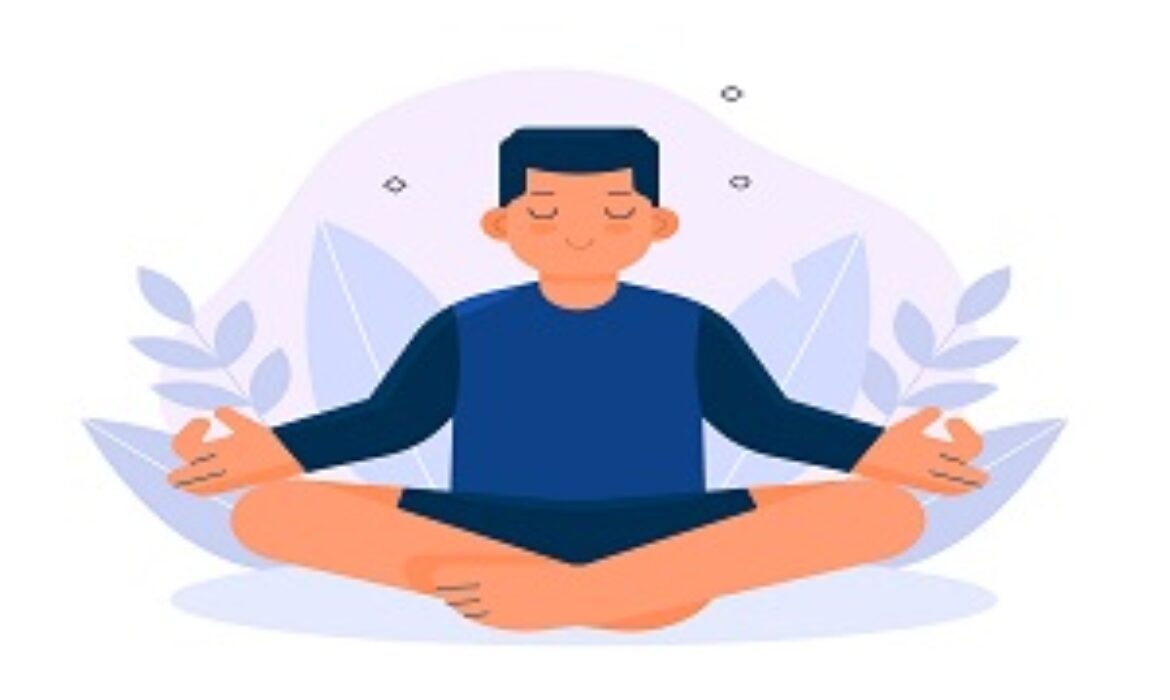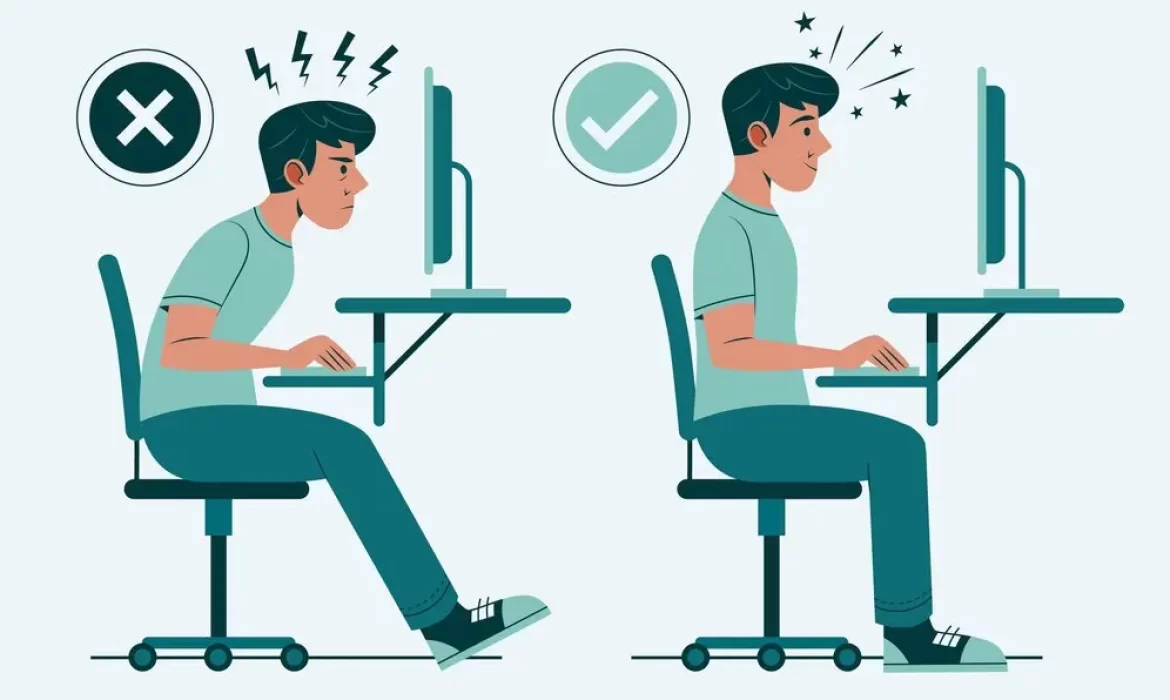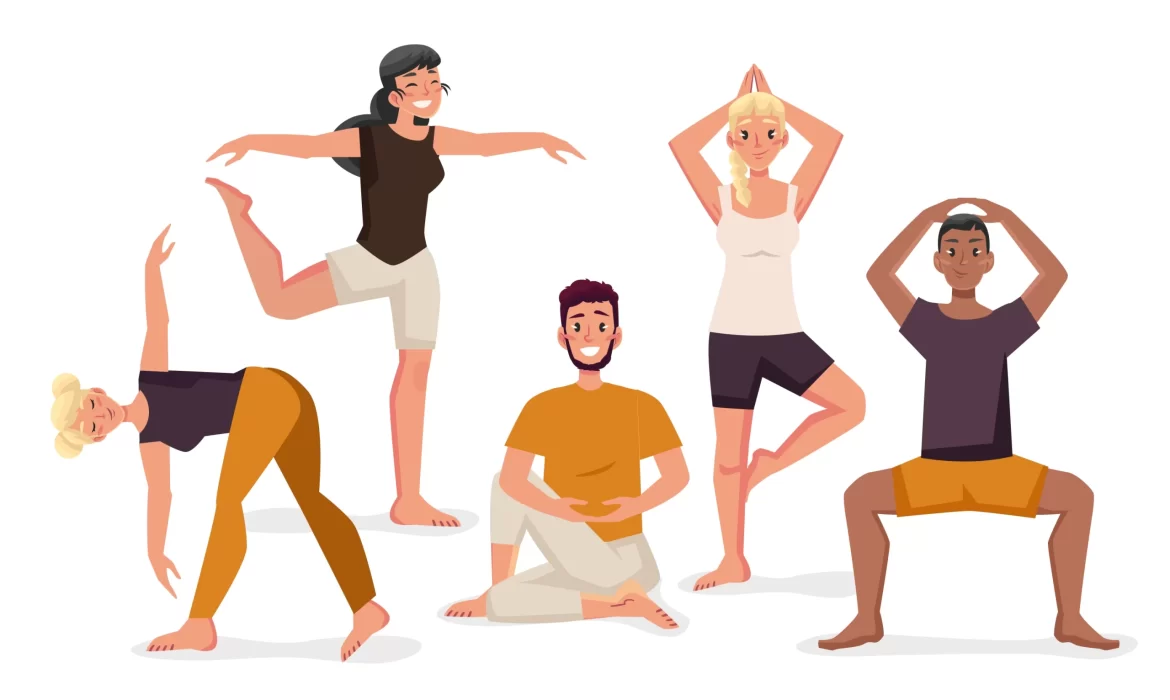What are the benefits of doing a GDA (general duty assistant) course?
Who is a GDA (General Duty Assistant)?

A General Duty Assistant is a medical official who provides end-to-end medical-related services to every type of medical institution. They assist the doctors and the nurses. They are responsible for taking dedicated care of the patients, looking after them 24/7, and ensuring an easy and stressless life for them.
A General Duty assistant is a professional who works dedicatedly for the patients, they provide medical attention to them when in need. A GDA’s primary task is to take full care of a patient – giving them medications, assisting them with food, putting their drips, giving them injections and even transporting them to washrooms or different wards.
They are responsible for providing proficient assistance to medical experts as well. Tasks like sterilizing the equipment, keeping them ready, and handing them to the doctors are done by General Duty assistants only. In complex situations like operations or emergencies, GDAs play a major role in helping doctors.
They also perform administrating tasks and maintain records, they are responsible for conducting admission and discharge formalities like coordinating with families and assisting them in fulfilling the formalities. Along with this they maintain records as well, patient records, their medical history, and every other task.
A General Duty Assistant is supposed to be attentive, in case of emergencies they are the first point of contact for the patient. This is why a General Duty Assistant must have quick reflexes.
They also provide clinical support for example measuring blood pressure, checking temperature, giving injections, putting drips, and collecting blood samples. By doing all of these vital tasks for medical administration, a GDA ensures the safety of a patient and makes them feel at home at a hospital.
Who is a GDA (General Duty Assistant)?
A General Duty Assistant is a medical official who provides end-to-end medical-related services to every type of medical institution. They assist the doctors and the nurses. They are responsible for taking dedicated care of the patients, looking after them 24/7, and ensuring an easy and stressless life for them.
A General Duty assistant is a professional who works dedicatedly for the patients, they provide medical attention to them when in need. A GDA’s primary task is to take full care of a patient – giving them medications, assisting them with food, putting their drips, giving them injections and even transporting them to washrooms or different wards.
They are responsible for providing proficient assistance to medical experts as well. Tasks like sterilizing the equipment, keeping them ready, and handing them to the doctors are done by General Duty assistants only. In complex situations like operations or emergencies, GDAs play a major role in helping doctors.
They also perform administrating tasks and maintain records, they are responsible for conducting admission and discharge formalities like coordinating with families and assisting them in fulfilling the formalities. Along with this they maintain records as well, patient records, their medical history, and every other task.

A General Duty Assistant is supposed to be attentive, in case of emergencies they are the first point of contact for the patient. This is why a General Duty Assistant must have quick reflexes.
They also provide clinical support for example measuring blood pressure, checking temperature, giving injections, putting drips, and collecting blood samples. By doing all of these vital tasks for medical administration, a GDA ensures the safety of a patient and makes them feel at home at a hospital.
GDA Nursing Course- Career Opportunities and Salary
Keeping the high demand for the GDA career, there are a lot of GDA courses available in the market. Mainly there are two types of GDA nursing courses – Online General Duty Assistant Course and Offline General Duty Assistant Course.
These GDA courses are made to provide the needed knowledge to the students who want to become professional GDA. They follow a comprehensive approach by focusing on providing maximum value to the students. They offer theoretical as well as practical training during the course.
Topics like providing nursing care, patient care, exploring hospitals, Record Management, Fundamental Aspects, Healthcare Institutions, General Health, etc are taught in these courses to equip the students with the required skill set to get a job in any medical institution.

Career Opportunities
According to The Economic Times India’s Healthcare sector is experiencing a growth of 12.59% in the year 2024-25. This was possible because of the investment of Rs 90,658.63 crore in the interim Budget by the Union Health Ministry.
Our healthcare sector has been growing since the year 2016, the graphs show an annual growth of (CAGR) 22 percent representing the endless number of job opportunities in the field. Our hospital market was valued at USD 98.98 billion in 2023 and is experiencing a growth of about CAGR of 8.0 percent in the year 2024. The market is predicted to reach USD 193.59 billion by the year 2032.
The healthcare sector will see massive growth this year (2024). The hiring rate will increase up to 15-20 percent, leading to a promising increase in the number of job openings.
These stats are proof showing the number of opportunities available in the Healthcare sector of India. Keeping these in mind you can easily get a job in medical institutions like:
- Hospitals and Clinics: Hospitals and Clinics are the prime locations where the General Duty assistants are posted for their duties. A professional General Duty Assistant is an essential part of a hospital or a clinic, as they are responsible for providing end-to-end care to the patients and also assisting the medical experts.
- Nursing Homes: Nursing homes or old age homes require GDAs to take close care of the patients. The patients in these places patients are mostly old which makes it hard for them to do daily tasks as well. This is where General Duty Assistants are needed. They help those patients in eating, bathing, making movements, and even transportation.
- At-home Services: When a patient is at their own home but still needs professional medical attention they hire or employ a General Duty Assistant. Which means taking care of a patient at their own house rather than in the hospital. A general Duty assistant goes to the house of the patient, offers them close and personalized medical attention, and then leaves.
- School and Colleges: Schools and Colleges also need General DUty assistants for the students. The presence of a lot of people in one place can lead to an unfortunate incident. In these places, General Duty Assistants are needed to provide first aid to the students in case of emergency and also provide them medical attention if they get sick on the premises.
- Military: The military is a place that is prone to casualties and injuries. Every base camp has a doctor to provide medical attention to the soldiers and along with a doctor, a General Duty Assistant is also deployed to assist the doctor and also do various medical tasks like providing first aid, dressing, collecting samples, and checking blood pressure and temperature.
Because of the versatile and highly performing profile, A General Duty Assistant is a reputed job and it opens doors to endless opportunities for long years.
Salary Structure of a General Duty Assistant:
There is no fixed salary for a General Duty Assistant though an average salary can be calculated. Irrespective of the sector salaries always depend on three factors that are experience, skill set, and location.
Below is an average salary structure of a General Duty Assistant in India:
- Fresher-level: 15000-25000 a month according to the skills and knowledge about the profession. Locations are also one of the factors.
- Mid-level: 35000-45000 per month (4-9 years of experience) can be negotiated depending on the experience and skills.
- Experienced: People who have gained experience of about 10 years or more can earn more.
Benefits of doing a GDA (General Duty Assistant) Course
- Skill Development: In these GDA courses, the main focus is on skill development. Being a GDA is not just about books having practical skills and experience is vital for the future. These courses provide both theoretical and practical knowledge making you an ideal candidate for job openings. Skills like providing nursing aids, patient care, exploring hospitals, Record Management, Fundamental Aspects, Healthcare Institutions, General Health, etc are taught in these GDA courses. These are the required skills to land any General Duty Assistant Job.
- High Demand: As the stats show our healthcare market is on a hike experiencing about 22 percent growth every year. These numbers represent the increase in job openings our healthcare sector will produce each year. There will more jobs each year which clearly states the need for General Duty Assistants. Being in a high-demand job profile, pursuing a GDA course can be beneficial for your career.
- Career Growth: If the medical sector is your dream then the General Duty Assistant course can help you achieve a flourishing career. As seen in the report by The Economic Times, India’s Healthcare sector has been growing since 2016 and growing by a CAGR of 8.0 percent each year. Which represents the number of career growth opportunities available in the field.
- Short Duration and Affordable: The GDA nursing courses are comparatively short-timed than other diplomas or degrees. Being of less duration they are also affordable as they charge comparatively less fees. This saves time and money.
- Personal and professional growth: If you take a General Duty Assistant course you don’t just gain professional skills you also earn personal traits like moral values, patience, and love which grow you as a human and teach you to take care of yourself as well. This creates room for both personal and professional growth. This was all about the GDA course if you want to be a General Duty Assistant do not waste your time go for it!
Frequently Ask Questions (FAQ)
A General Duty Assistant assists the nurses, nurses are often responsible for doing more complex tasks than the GDAs. To become a GDA you can take a short period of the training course and start working, unlike Nursing asks for either a bachelor’s or an accredited training program.
The Nurses are responsible for wider tasks like complex medical procedures, and providing education regarding the procedures. The GDAs are responsible for minor and daily tasks like bathing, feeding, etc.
Being a General Duty Assistant you must have the needed skills. A person should be personally and professionally skilled to become a professional GDA. Below are the skills that a person should have:
- Physically and Mentally Fit
- Patience
- Strong Morals
- Quick reflexes
Apart from professional skills, these are some moral and mental skills, one must have to become professionally strong.
The job of a General Duty Assistant is very exhausting and rewarding at the same time. This job can be physically challenging as you might have to run from floor to floor in emergencies. This job even puts mental stress on an individual as taking close care of patients and being in an environment where everybody is sick and people are dying can cause severe effects on the mental health of an individual.
In order to become a General Duty assistant you must be at least 18 years of age. You should be the 12th pass from a reputed board and you should have completed a General Duty Assistant course if you want to work as a professional full-time General Duty Assistant.
Top 11 Yoga Asanas and Their Benefits
Today’s fast-moving world has taught us to follow trends. There are a lot of trends like trendy clothes, trendy gadgets, and appliances but unfortunately, there is no such trend of being healthy. We are running to achieve materialistic things but we are leaving our health behind and this is the worst we could do to ourselves.
Having body pain, anxiety, high blood pressure, stress, and frustration all these things have become so common among us. All of us are either suffering from one of these or all of these. These are symptoms of poor mental and physical health which is a result of poor lifestyle.
If you are not familiar with yoga, don’t worry. Various Yoga online courses can teach you the basics of yoga. You can learn theory and practical both. The best part about online yoga courses is that you don’t have to leave your comfort zone.
Having physical and mental health issues is no joke they should be cured as soon as possible. Yoga is the ultimate solution to all these lifestyle-related issues. Yoga was introduced thousands of years ago and it is still practiced all across the globe. There must be something special about yoga that makes it immortal.
If you feel stuck, being a beginner and feeling confused is normal. There are certain ways by which you can start your yoga journey smoothly:
- First of all, find a comfortable and quiet place, choose any corner of your house that should be slightly lit and there should be no noise disturbances and there should be positive vibrations all over the place.
- Once you have found your perfect corner place any mat and sit down. You can sit on the floor if you do not have a mat.
- Start with basic stretching and try doing basic yoga poses. Start with small, start with 10-15 minutes every day.
- Once it turns into a habit gradually increase the time and complexity of the asanas.
Below are the Top 11 Yoga Asanas and Their Benefits
Tadasana

Tadasana is also known as Mountain Pose. This asana is the foundation of all the poses, it teaches balance and focuses on breathing.
Steps to perform Tadasana:
- Stand with your feet together and keep your heels a little apart.
- Distribute your weight evenly on your feet.
- Relax your body and slowly lift your heels to stand on your toes.
- Now lift your hands in the air straight and hold this position for 30 seconds then release.
Benefits: This asana provides strength in your thighs, knees, and shoulders. You can learn to focus on your breathing through this asana. Tadasana also promotes flexibility.
Bhujangasana
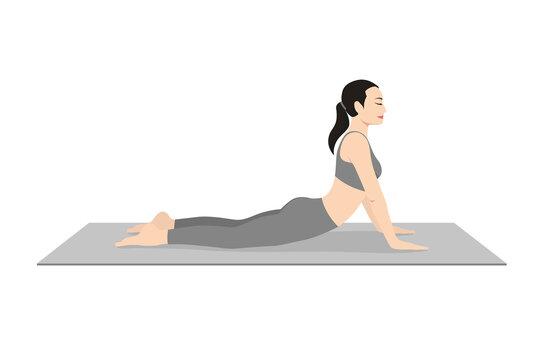
Bhujangasana is also known as the cobra pose because of its formation of like a snake. This asana provides strength in the spine and it also promotes flexibility.
Steps toperform bhujangasana:
- Lie down flat on your stomach and keep your elbows close to your body.
- Firmly put your feet on the floor, Make a grip.
- Inhale and slightly lift your chest with the help of your spine.
- Be in a push-up-like position then stretch your elbows, and keep them a bit folded.
- Hold the pose for 15-30 seconds and then slowly release.
Benefits: This asana strengthens your spine. It also relieves lower back pain and increases flexibility.
Adho Mukha Savanasana
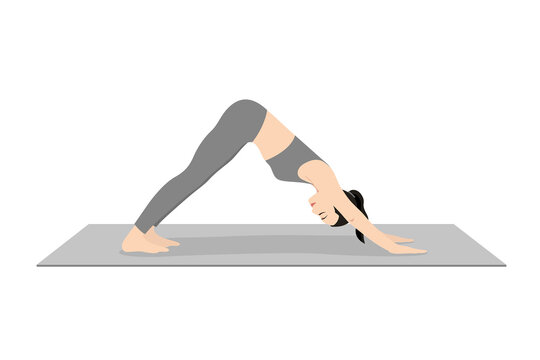
Adho Mukha Savasana is also known as the downward dog pose. This asana is very easy to perform it provides strength to the thighs, calves, and spine.
Steps to perform Adho Mukha Savanasana:
- Stand firmly on the mat and distribute your weight evenly.
- Now bend down and put your hands on the floor, do not fold your knees.
- Keep your hands apart from your legs. Spread your fingers and make a grip.
- Push your feet towards the ground and while doing this lift your hips.
- Do this while stretching your spine keeping it long.
Benefits: This asana has both physical and mental health benefits it helps in relieving stress, provides peace, and also strengthens your spine.
Vajrasana
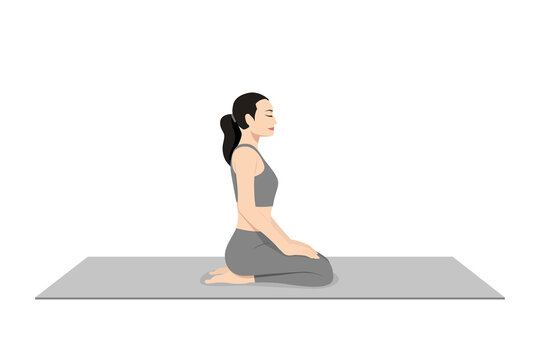
Vajrasana is also known as the diamond pose. This asana is a proven way to improve digestion and reduce lower back pain. This asana can be done after eating food.
Steps to perform Vajrasana:
- Sit on the floor with your legs folded under your thighs.
- Keep your heels under your hips, and keep your back straight. Stretch your spine.
- Rest your hands on your thighs while performing this asana.
- Close your eyes and take 5-10 deep breaths.
- Hold this pose for 5-10 minutes.
Benefits: This asana results in good gut health as it promotes healthy digestion, it also cures lower back pain and strengthens your pelvic muscles.
Naukasana
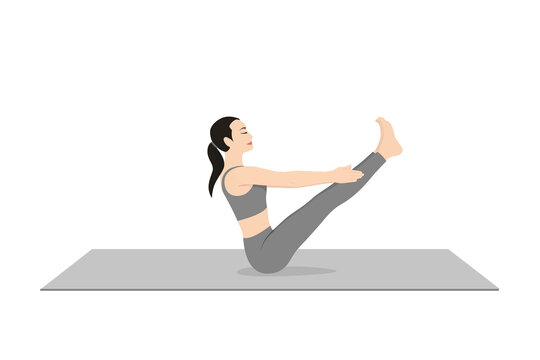
Naukasana is also known as boat pose as the nauka means boat. This asana targets the core and improves the digestive system.
Steps to perform Naukasana:
- Lie straight on your back with your legs straight, and keep your hands along your legs.
- Now lift your upper and lower body together towards each other. Stretch your hands towards your legs.
- Maintain this pose only the hip area will be on the floor, keep looking in front.
- Try to balance this and hold it for 15-30 seconds then release.
Benefits: This asana makes your core strong. It makes your abdomen and spine strong. It promotes balance and flexibility in the body.
Balasana
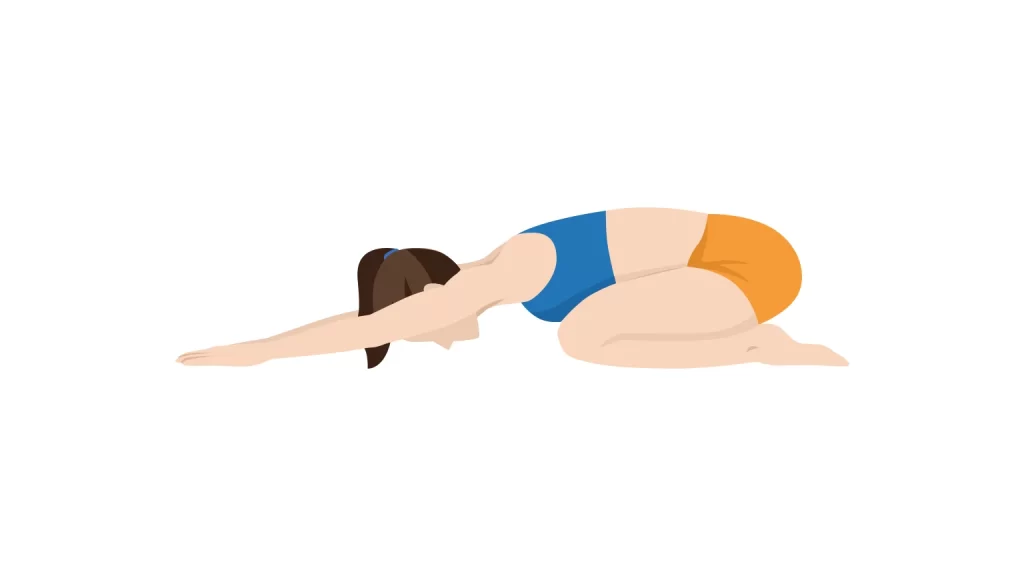
Balasana is also known as the child pose. This asana is good for the back and it also improves mental health.
Steps to perform balasana:
- Start by sitting on the floor, now bend your knees, and put your heels under the hips.
- Sit as you sit in Vajrasana but keep your knees a little apart.
- Now hold your knees with your hands and bend forward.
- Try to touch your forehead to the floor.
- Hold this position for 30 seconds or a minute.
Benefits: This asana is a proven way to improve your mental health, it relieves your stress and also strengthens your core.
Paschimottanasana
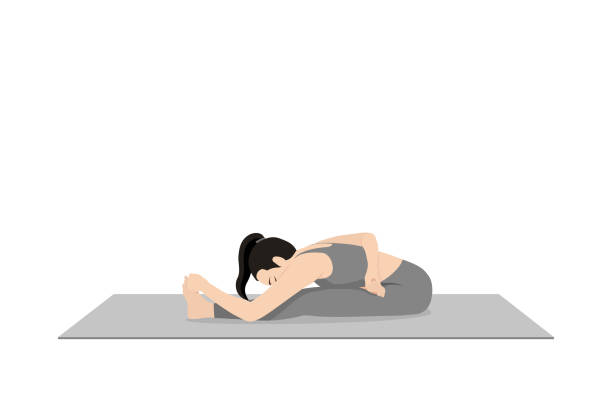
This asana is also known as the seated forward bend pose and west stretching pose. This asana improves flexibility significantly.
Steps to perform Paschimottansana:
- Sit on the floor and lay your legs straight.
- Join your legs and stretch them long in front of you.
- Inhale and stretch your spine then exhale then stretch your hands to reach the feet.
- Touch your feet and try to touch your forehead to the knees.
- Try to hold this position for 1-3 minutes.
Benefits: This asana strengthens the spine, it is a good way to stretch your whole body. It cures back pain.
Dhanurasana
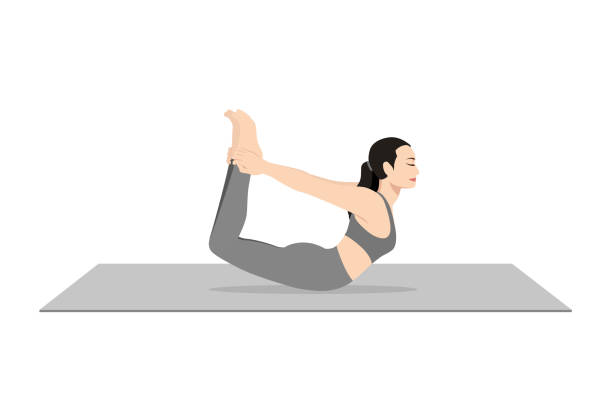
This asana is also known as the Bow pose.
Steps to perform Dhanurasana:
- Lie on your stomach with your hands alongside your body.
- Now while lying on the floor try to reach your ankles with your hands.
- Inhale and lift your chest to hold your ankles pull your ankles towards your shoulders and stretch them.
- Hold this for 15-30 seconds.
Benefits: This asana improves posture. It stretches the chest and shoulders and also strengthens your back muscles.
Kakasana
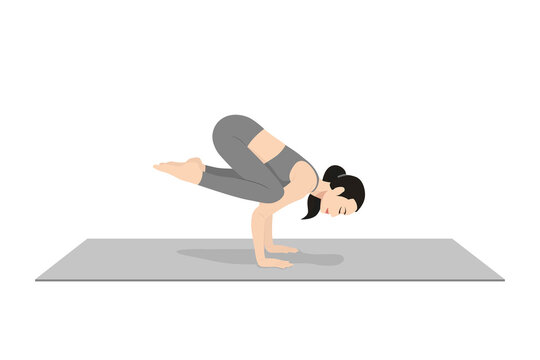
This asana is also known as the crow pose. This asana makes you look like a bird who is standing on two hands. This asana can be a little complicated for beginners.
Steps to perform Kakasana:
- Sit in the squat position. Put your hands on the floor like a frog.
- Now lift your hips and bend your knees. Place your knees on your upper arms.
- Put all your weight on the hand and try to balance.
- Try to hold this position for 10-20 seconds.
Benefits: This asana provides immense strength to the hands and wrists, It also increases balance and flexibility.
Ustrasana
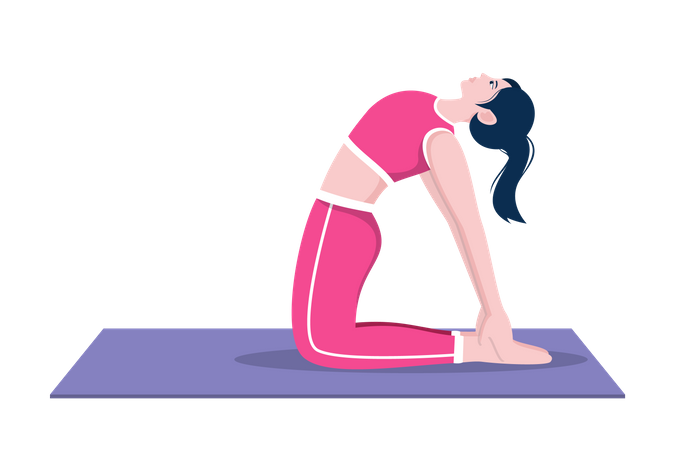
This asana is also known as the camel pose. This pose stretches the whole body at once.
Steps to perform Ustrasana:
- Kneel on the floor and keep your body straight.
- Keep your knees hip-width apart. Now stretch your body backwards and touch your heels.
- After touching your heels from the back of your body. Create an arch with your back.
- Hold it for 25-30 seconds.
Benefits: This asana is good for digestive organs. It also stretches the whole front of your body.
Natarajasana
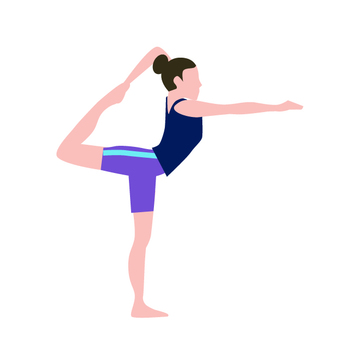
This asana is also known as the Dancer pose.
Steps for performing Natrajasana:
- Stand on your feet and put your whole weight on the left foot.
- Lift your right knee and try to hold the ankle of your right leg with your right hand.
- Now put your left hand in front and stretch your right leg backward.
- Now hold this position for 30-6- seconds and do it for both the legs.
Benefits: It stretches the back and the legs. It improves spine health and balance.
These are some best yoga asanas that target your whole body. This comprehensive list combines asanas that provide mental and physical health benefits. Performing yoga daily can have positive effects on your body. Remember to be consistent with your goals. Stay happy stay healthy!
Frequently Ask Questions (FAQ)
Yoga is a vast concept, the exact number of asanas cannot be calculated but an estimate can be given through the different forms of yoga.
- Hatha Yoga – It includes around 84 asanas.
- Vinyasa Yoga – It includes nearly 12 asanas.
- Ashtanga Yoga – Includes around 75 asanas.
- Iyengar Yoga – Includes 200 asanas and 14 kinds of breathing exercises.
- Kundalini Yoga – Includes around a dozen asanas.
- Bikram Yoga – 26 asanas.
- Yin Yoga- Have 20-30 poses.
- Restorative Yoga- around 5-10 poses.
- Power Yoga- includes 30-50 poses.
- Prenatal Yoga – Includes around 20-30 poses.
There are around basic 10 types of yoga:
- Hatha Yoga – The basic foundation of all yoga poses. It teaches balance and breathing techniques.
- Vinyasa Yoga – This kind of yoga includes a sequence of poses, it includes flowing from one pose to another pose smoothly.
- Ashtanga Yoga – This yoga follows a sequence of poses, it is a fast-paced type of yoga.
- Iyengar Yoga – This kind of yoga includes props and it focuses on the alignment of the body.
- Kundalini Yoga – This yoga focuses on the kundalini energy of the human body, it includes chanting.
- Bikram Yoga – This is also known as hot yoga, it is performed in a heated room. It includes 26 poses that are performed in sequence.
- Yin Yoga – Slow and peaceful type of yoga in which poses are held for longer periods.
- Restorative Yoga- This type of yoga focuses on mental health. It relieves stress and also uses props to support the body.
- Power Yoga – It is just a fast-paced version of vinyasa yoga.
- Prenatal Yoga – Specially made for pregnant women to promote natural delivery and good health.
Yes! Pregnant women can perform yoga which does not put stress on their abdomen. Pregnant women should avoid Front bends, back bends, Lying on the belly, and inverted poses.
You can perform these asanas and they will benefit your health during pregnancy:
- Marjaryasana/Bitilasana
- Virabhadrasana II
- Baddha Konasana
- Utthita Parsvakonasana
- Vrksasana
- Malasana
- Balasana
These asanas can have positive effects on your health and also promote a natural and smooth delivery process.
Doing yoga empty stomach is preferred. If you are empty stomach you can focus more, increased efficiency, and chances of nausea are less.
Even if you are not empty stomach you should wait at least 45 minutes before performing yoga.
What is Ergonomics and their Advantages
What is Ergonomics
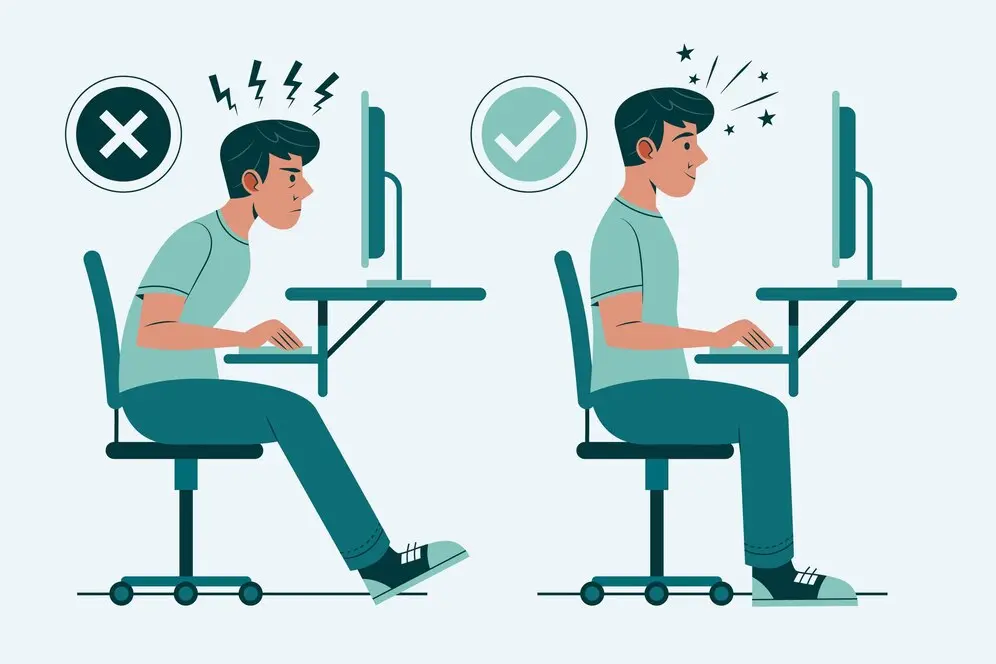
The process followed in designing or arranging different environments, products and services in such a way that fit the people who make use of them is called ergonomics.
By bringing together knowledge from various disciplines such as psychology, sociology, visual design, user experience design, industrial design, etc. and integrating them with engineering and design of products, systems, environments and processes, ergonomics reduce human error along with substantially improving their productivity along with their safety and health.
It is also known as Human Factors Engineering (HFE).
What is Ergonomics
The process followed in designing or arranging different environments, products and services in such a way that fit the people who make use of them is called ergonomics.
By bringing together knowledge from various disciplines such as psychology, sociology, visual design, user experience design, industrial design, etc. and integrating them with engineering and design of products, systems, environments and processes, ergonomics reduce human error along with substantially improving their productivity along with their safety and health.
It is also known as Human Factors Engineering (HFE).

Importance of Ergonomics

While in the workplace or while doing a job, people are susceptible to discomfort due to awkward posture, extreme temperature or perhaps some other stressor. Sometimes people also have a habit of repetitive movements. These factors, a lot of the time, may cause musculoskeletal disorders which sometimes even turn into long-term disabilities.
Ergonomics or Human Factors Engineering is relevant in designing furniture or products that can prevent these musculoskeletal disorders and boost the user’s productivity while keeping them healthy and pain free. With the implementation of ergonomic solutions in workplaces and products, employees will not only be more comfortable but also more efficient. Thus, ergonomics is not only beneficial for a person’s health but also beneficial to companies as it increases the rate of efficiency.
How Does Ergonomics Work?
Ergonomists use a multitude of data and techniques belonging to several disciplines
levers, strengths
Advantages of Ergonomics
Increased productivity
Ergonomics carries along with it a plethora of advantages. Some of them being:
Workplaces that are ergonomic are most of the time, if not all, efficient workplaces. Ergonomic improvements in the workplace can reduce the main risk factors that lead to musculoskeletal disorders. They provide workers/employees with greater job satisfaction, enhanced focus and greater mental clarity.
Ergonomics often boosts morale as well, since it makes employees feel cared for.
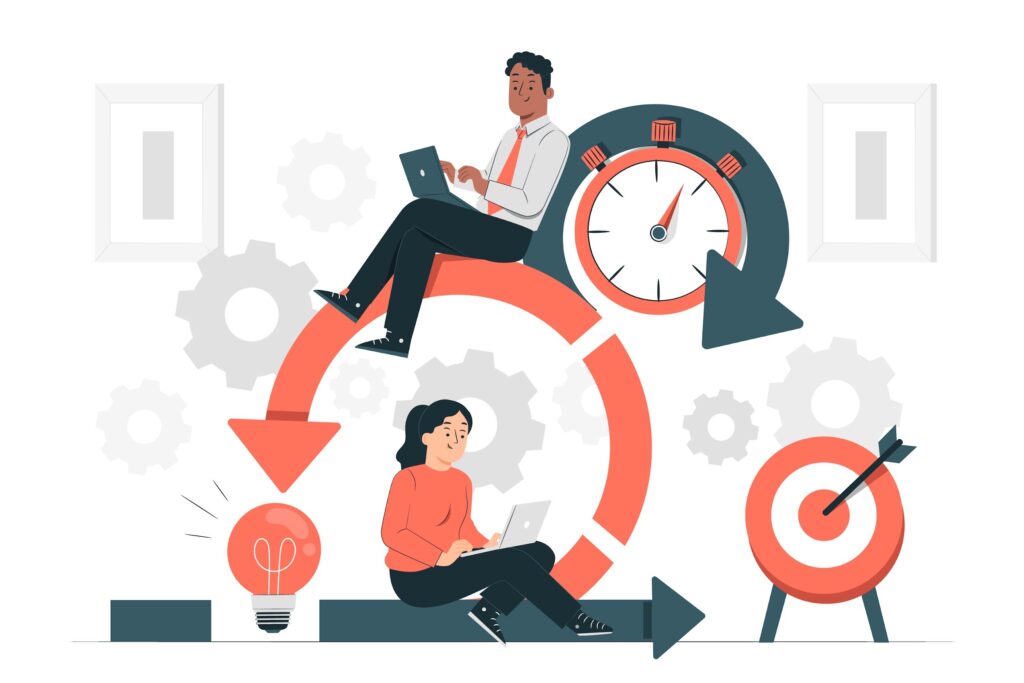
Improved comfort and health benefits
In a workplace, to be productive, convenience and comfort is crucial. Thus, ergonomic designs provide employees with comfort and the convenience that is necessary. Besides comfort, ergonomics carries with it a plethora of health benefits. Its effect starts within the cardiovascular system and eventually moves to other parts of the body.
Ergonomics makes a working environment healthy and reduces stress hence, it improves cardiovascular health and also reduces any chance of workplace injuries.
Lower Insurance Costs

Ergonomic designs reduce the risk of employees suffering from workplace injuries or illnesses. Products and equipment such as an ergonomic sit and stand up desk, keyboard and mouse, which can be adjusted according to the needs of the employees can help reduce employee burnout or stress and even improve the working environment as a whole. Thus by implementing ergonomics in the workplace, the insurance costs are liable to significantly decrease.
Lower Insurance Costs
Ergonomic designs reduce the risk of employees suffering from workplace injuries or illnesses. Products and equipment such as an ergonomic sit and stand up desk, keyboard and mouse, which can be adjusted according to the needs of the employees can help reduce employee burnout or stress and even improve the working environment as a whole. Thus by implementing ergonomics in the workplace, the insurance costs are liable to significantly decrease.

Safety
Ergonomics, if implemented in a workplace, creates a safe work environment, one that is easy to access, use and work in without much risk of any workplace injuries or illnesses. Ergonomics also has a multitude of health benefits, so by improving workstations or workplaces in an ergonomic way, employees will remain healthy at work and provide them with a safe environment that they can do well in.
Reduction of Absenteeism
The implementation of ergonomics also leads to elimination of hazards that can be found in daily life. Ergonomics identifies and reduces hazards in the workplace by creating a more user-friendly environment. To add, it also reduces distractions, provides adjustable furniture and equipment and also allows users to adjust the lighting or ventilation according to their needs. Ergonomics reduces absenteeism since it reduces the amount of workplace injuries that may lead to employees taking leaves and missing work days. Ergonomics in a working environment also reduces employee fatigue and stress which a lot of the time, contribute to absenteeism.
Improved mental clarity
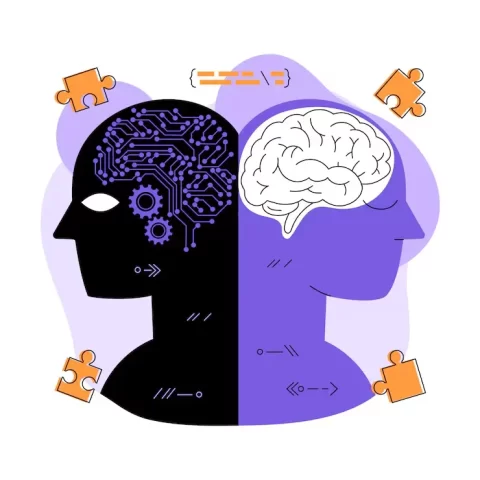
Other than comfort and physical health, ergonomics also improves the mental clarity of the employees. Since it provides comfort and reduces workplace injuries, it reduces anxiety since blood flow is unrestricted and flowing freely, muscles are relaxed and thus keeps the employees in a good mood. All these factors combined together, provide employees with greater mental clarity and hence improves quality of work.
7 Benefits of Yoga
These days we are so busy with our modern lifestyle that we leave the quality of life behind. This fast-paced world has adversely affected our bodies and minds. Leaving harmful side effects on our overall health.
You cannot keep ignoring your health for long. Depreciating health shows various symptoms like eating habits, bad gut health, weak joints, mental illness, etc. Yoga is the ultimate solution to all these issues.
Taking a step towards your health is like a battle but if you have decided, you have already won half of it! Yoga is a perfect combination that will help you heal your body and mind together. The most difficult part is starting, taking time out from busy schedules can be hard but Online Yoga Courses can help.
Below are some benefits of yoga that will convince you to take a step forward
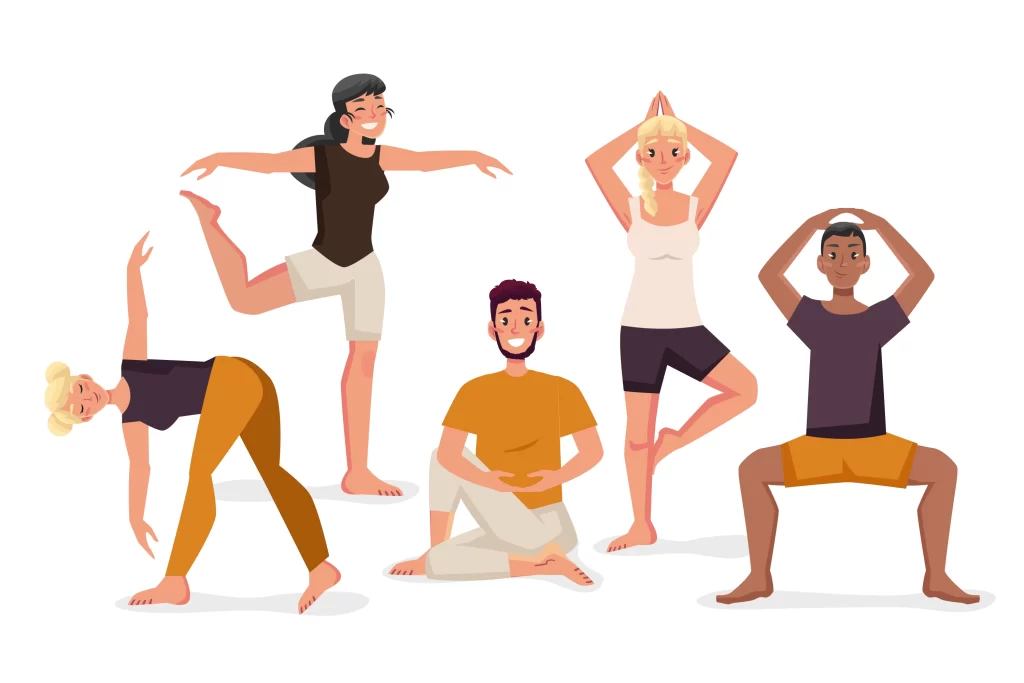
Improved Physical Health
A busy lifestyle and tight schedules result in falling physical health. Having no time to exercise or even do basic stretching is very normal these days. All these changes in our daily lives affect our physical health in a bad way.
For this type of schedule and lifestyle yoga suits the best. Yoga is a perfect solution to all health-related issues. If you are just starting, start with small. Taking out 10-15 minutes daily is relatively easy.
Wake up in the morning, choose a silent and comfortable place, put your mat, and start with basic yoga poses. Then you can gradually increase the time and complexity of the session according to your pace and body goals.
Doing this daily will prevent heart-related diseases, will make your gut healthier, and will heal your body from within.
Improved Physical Health
A busy lifestyle and tight schedules result in falling physical health. Having no time to exercise or even do basic stretching is very normal these days. All these changes in our daily lives affect our physical health in a bad way.
For this type of schedule and lifestyle yoga suits the best. Yoga is a perfect solution to all health-related issues. If you are just starting, start with small. Taking out 10-15 minutes daily is relatively easy.
Wake up in the morning, choose a silent and comfortable place, put your mat, and start with basic yoga poses. Then you can gradually increase the time and complexity of the session according to your pace and body goals.
Doing this daily will prevent heart-related diseases, will make your gut healthier, and will heal your body from within.

Improved Mental Health
According to WHO 280 million people on earth are depressed from teenagers to adults most of us are dealing with some kind of mental pressure right now. This pressure can come from anywhere from family, workplace, friends, or even your past experiences. This pressure is soon turned into trauma which is followed by depression.
Between all this commotion we seek for peace that can calm our mind. This peace can be retrieved from yoga. Several yoga poses like Balasana, Trikonasana, Savasana, etc. can provide relief in symptoms of depression.
Practicing yoga daily will help you connect to yourself, and know yourself which is very crucial for a healthy mind. This can calm your anger, can teach you to manage stress, and even lower your anxiety levels. Yoga is a proven path that can lead you to a healthy self.
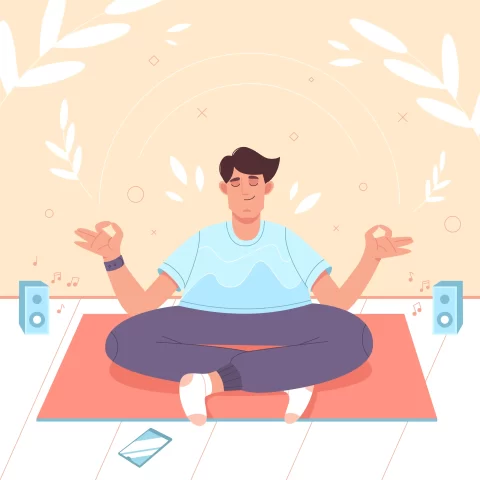
Improved Mental Health
According to WHO 280 million people on earth are depressed from teenagers to adults most of us are dealing with some kind of mental pressure right now. This pressure can come from anywhere from family, workplace, friends, or even your past experiences. This pressure is soon turned into trauma which is followed by depression.
Between all this commotion we seek for peace that can calm our mind. This peace can be retrieved from yoga. Several yoga poses like Balasana, Trikonasana, Savasana, etc. can provide relief in symptoms of depression.
Practicing yoga daily will help you connect to yourself, and know yourself which is very crucial for a healthy mind. This can calm your anger, can teach you to manage stress, and even lower your anxiety levels. Yoga is a proven path that can lead you to a healthy self.

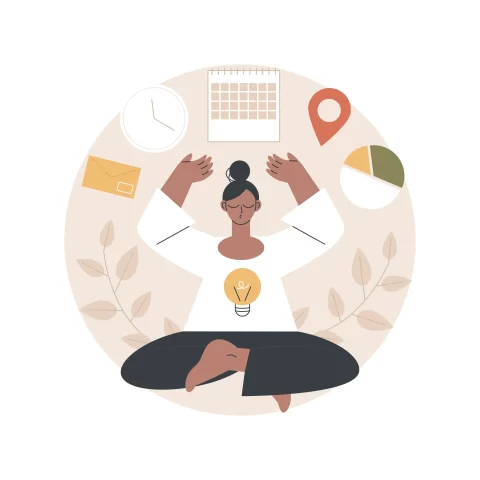
Increased Discipline
To keep everything on track discipline is important, be it health or life. Discipline is an important ingredient of any success story. No goal can be achieved without it and this is why it is the first thing taught to us in schools.
Yoga is a practice and every practice needs discipline. Once you start practicing yoga daily this task will turn into a habit in no time. Yoga teaches you to be disciplined, each pose has to be done in a certain manner without mistakes.
When you perform tadasana you have to stand on your toes with your hands in the air. In this asana, you need discipline and balance so that you do not fall. Your life is like an asana pave it with balance and discipline so that you do not fall and stand strong in front of any challenge you face in your life.
Increased Discipline
To keep everything on track discipline is important, be it health or life. Discipline is an important ingredient of any success story. No goal can be achieved without it and this is why it is the first thing taught to us in schools.
Yoga is a practice and every practice needs discipline. Once you start practicing yoga daily this task will turn into a habit in no time. Yoga teaches you to be disciplined, each pose has to be done in a certain manner without mistakes.
When you perform tadasana you have to stand on your toes with your hands in the air. In this asana, you need discipline and balance so that you do not fall. Your life is like an asana pave it with balance and discipline so that you do not fall and stand strong in front of any challenge you face in your life.

Increased Concentration
When we start going to school we are taught about concentration. We often hear, concentrate on yourself, concentrate on your career, concentrate on your studies. But still, we do not give it the importance it deserves.
Concentration is important but concentrating on the right thing is crucial. This crucial habit is taught by Yoga. Yoga is not just a physical practice it is a spiritual connection too. It was introduced thousands of years ago and is still in practice and the main reason is its amazing healing properties.
Hatha Yoga specifically improves concentration and memory power. Practicing yoga daily will increase your concentration skills and you will be able to stick to one thing for a longer time. Investing in the right things will lead you to the staircase of success. Concentration and distraction are the two faces of a coin. You have to choose one.
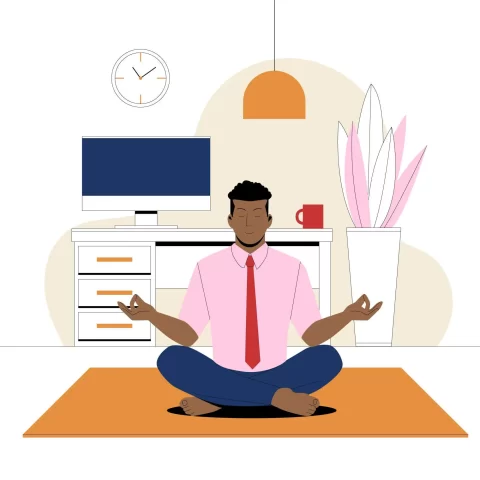
Increased Concentration
When we start going to school we are taught about concentration. We often hear, concentrate on yourself, concentrate on your career, concentrate on your studies. But still, we do not give it the importance it deserves.
Concentration is important but concentrating on the right thing is crucial. This crucial habit is taught by Yoga. Yoga is not just a physical practice it is a spiritual connection too. It was introduced thousands of years ago and is still in practice and the main reason is its amazing healing properties.
Hatha Yoga specifically improves concentration and memory power. Practicing yoga daily will increase your concentration skills and you will be able to stick to one thing for a longer time. Investing in the right things will lead you to the staircase of success. Concentration and distraction are the two faces of a coin. You have to choose one.

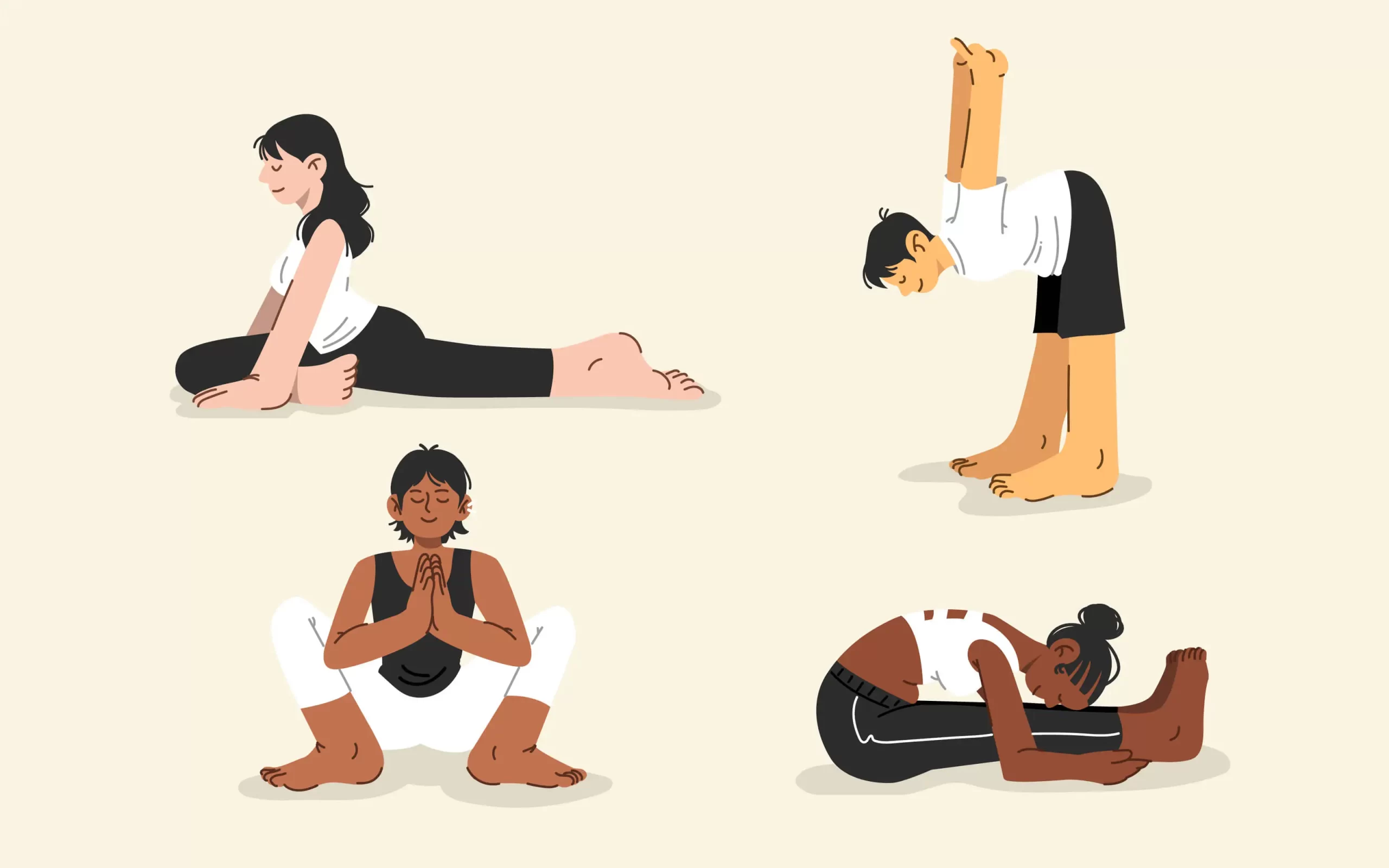
Better joint Health
Joints join our bones and our bones collectively frame our body. Joints are the building blocks of our body. They are very important for our daily life and movements. There are a lot of people who face joint-related pains and there are people who have weak joints.
These kinds of people cannot perform vigorous activities like running, jogging, dancing, etc. to keep themselves healthy. People having weak joints or people who have joint-related diseases are advised to practice yoga by professional doctors.
Yoga as a practice is very calm and soothing, it does not involve any rigorous movements. Activities like jumping are not a part of yoga. Yoga includes poses and these poses are done very peacefully by standing at one place on a mat.
Being a non-vigorous sport, yoga does not put any kind of stress on your joints. It includes basic stretching and asanas that target your muscles. So, yoga does not just heal joints, it also keeps them healthy and prevents any kind of joint-related diseases.
Better joint Health
Joints join our bones and our bones collectively frame our body. Joints are the building blocks of our body. They are very important for our daily life and movements. There are a lot of people who face joint-related pains and there are people who have weak joints.
These kinds of people cannot perform vigorous activities like running, jogging, dancing, etc. to keep themselves healthy. People having weak joints or people who have joint-related diseases are advised to practice yoga by professional doctors.
Yoga as a practice is very calm and soothing, it does not involve any rigorous movements. Activities like jumping are not a part of yoga. Yoga includes poses and these poses are done very peacefully by standing at one place on a mat.
Being a non-vigorous sport, yoga does not put any kind of stress on your joints. It includes basic stretching and asanas that target your muscles. So, yoga does not just heal joints, it also keeps them healthy and prevents any kind of joint-related diseases.

Increased Flexibility and Balance
Being flexible and balanced in your life and your body are very essential. All of us are living on the edge; nobody has time for anybody, not even themselves. Due to this, we do not put effort into our bodies. No movements can lead to a nonflexible body.
Who wants a non-flexible body? It gives you cramps, it makes basic movements difficult. “I am not flexible, I cannot practice yoga!” This is a very common myth. People perform yoga to get flexible, and even if you are not flexible you can practice yoga.
Practicing yoga daily will make your body more flexible than ever. Yoga stretches your muscles which makes you flexible. Asanas like Downward Dog, Cow Face Pose, Cobra Pose, etc. These are the perfect asanas to increase flexibility.
Flexibility and Balance are the basics of any yoga pose, thus if you practice yoga daily you will gain flexibility and balance in your body and life as well.
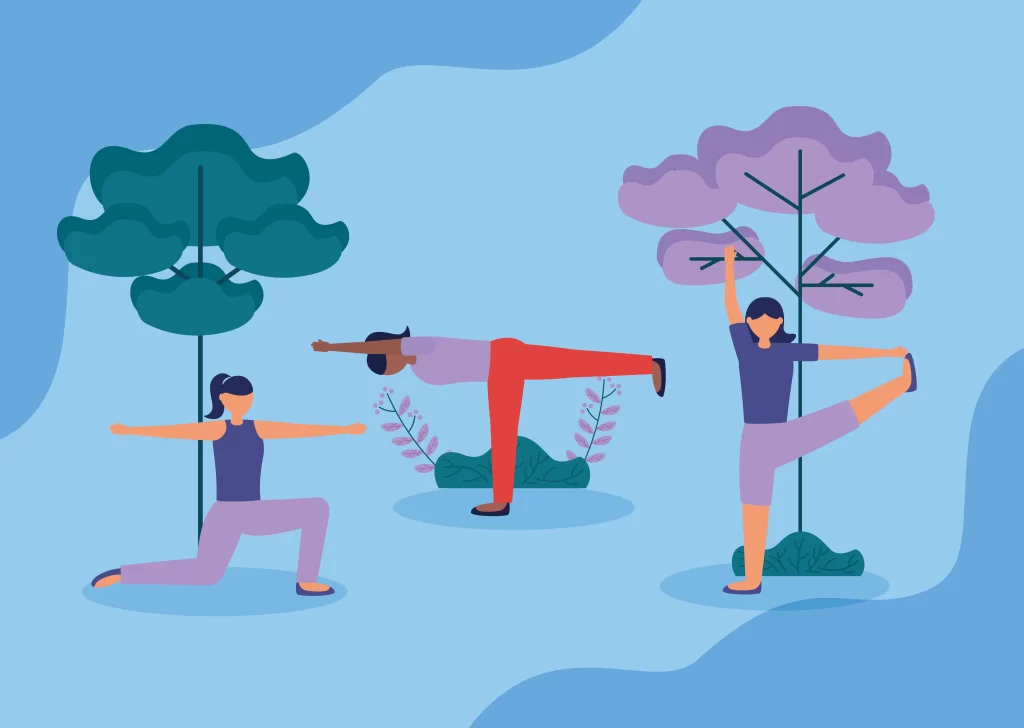
Increased Flexibility and Balance
Being flexible and balanced in your life and your body are very essential. All of us are living on the edge; nobody has time for anybody, not even themselves. Due to this, we do not put effort into our bodies. No movements can lead to a nonflexible body.
Who wants a non-flexible body? It gives you cramps, it makes basic movements difficult. “I am not flexible, I cannot practice yoga!” This is a very common myth. People perform yoga to get flexible, and even if you are not flexible you can practice yoga.
Practicing yoga daily will make your body more flexible than ever. Yoga stretches your muscles which makes you flexible. Asanas like Downward Dog, Cow Face Pose, Cobra Pose, etc. These are the perfect asanas to increase flexibility.
Flexibility and Balance are the basics of any yoga pose, thus if you practice yoga daily you will gain flexibility and balance in your body and life as well.

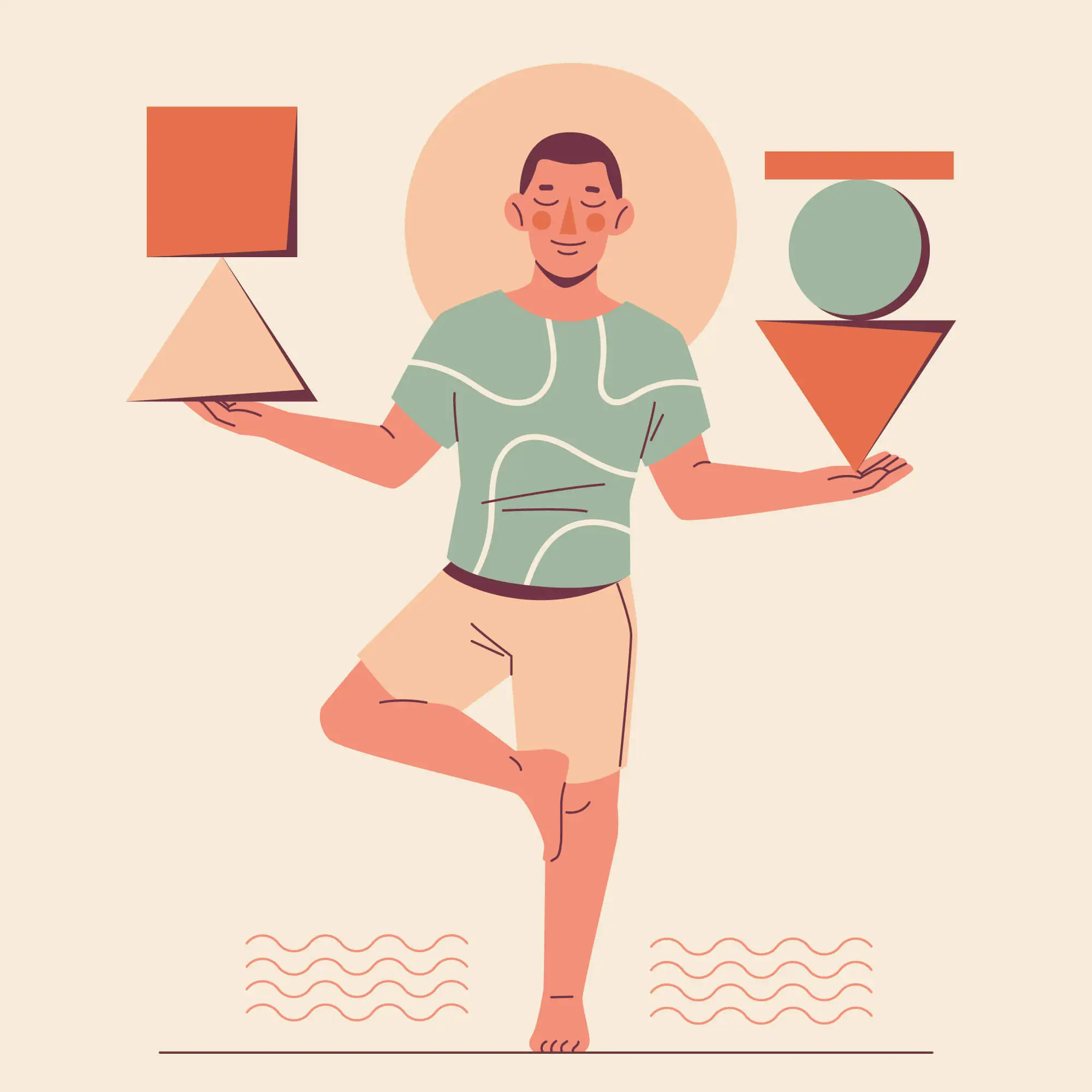
Balanced Life
A balanced life can only be seen in books these days, it’s not a practical thought anymore. We cannot blame anybody but us. We are at fault, but change starts with an individual, and that individual can be you, us, or anybody else.
And that change is yoga, if you have gained all the above-mentioned points then congratulations you have a balanced life. A balanced life is no rocket science. If you are happy with what you have you are already in a balanced life.
These were some crucial benefits that yoga holds. We hope these were enough for you to start working toward yourself daily. Back in the time when school did not exist, yoga was there to teach us the fundamentals of life through asanas and scriptures. Yoga is an important part of our lives. Now that we have developed, learning yoga has become easier.
Several Yoga online courses will teach you this revolutionary art without even leaving your home. Yoga has evolved and so have learning experiences. Enroll today in Kontentedge’s online Yoga course to transform yourself inside out!
Balanced Life
A balanced life can only be seen in books these days, it’s not a practical thought anymore. We cannot blame anybody but us. We are at fault, but change starts with an individual, and that individual can be you, us, or anybody else.
And that change is yoga, if you have gained all the above-mentioned points then congratulations you have a balanced life. A balanced life is no rocket science. If you are happy with what you have you are already in a balanced life.
These were some crucial benefits that yoga holds. We hope these were enough for you to start working toward yourself daily. Back in the time when school did not exist, yoga was there to teach us the fundamentals of life through asanas and scriptures. Yoga is an important part of our lives. Now that we have developed, learning yoga has become easier.
Several Yoga online courses will teach you this revolutionary art without even leaving your home. Yoga has evolved and so have learning experiences. Enroll today in Kontentedge’s online Yoga course to transform yourself inside out!

Frequently Ask Questions (FAQ)
This question often confuses our minds. Is yoga different from meditation? Well yes! Yoga is a different practice than meditation.
Yoga is a practice that emphasizes overall health- physical, mental, and spiritual. Different Yoga asanas are made to focus on different goals.
For example, to focus on physical health you should practice:
- Hatha Yoga
- Vinyasa Yoga
- Ashtanga Yoga
- Bikram Yoga
- Power Yoga
These types of yoga practices will help you in improving your physical health.
To focus on your mental health you perform these yoga types:
- Restorative Yoga
- Yin Yoga
- Kundalini Yoga
- Iyengar Yoga
- Yoga Nidra
These yoga types will focus on your mental health and will help you improve it gradually. You can choose the type of yoga depending on your needs and goals.
Now talking about Meditation, meditation is a mindful practice that focuses just on your mental health. Meditation is an effective way to know about yourself, connect to yourself, and heal from within.
There are types of meditation:
- Mindfulness Meditation:
- Loving-kindness Meditation
- Visualization Meditation
- Breath Awareness Meditation
Each type of meditation helps in healing differently. Meditation is a practice that will help you lower your blood pressure, and your anxiety levels and also will teach you stress management.
This is the basic difference between yoga and meditation, you can choose between them depending on your personal needs.
Taking care of your health has become a tedious task these days. We all have busy schedules and lifestyles and taking out time for yourself is not easy. These busy schedules affect your health in the worst ways.
Having no or a high appetite, mental health disorders, body pains, disturbed mind all are symptoms of poor health. And a majority of us are suffering from them already. If you are suffering from even one of these it’s time for you to take a step forward for your own health before it’s too late.
Where there is a problem, there is a solution, and the solution to this problem is yoga. Yoga is the ultimate solution to all mental and physical health issues. If you are a beginner and want to start a yoga schedule you are on the right path.
You can perform yoga anywhere you don’t have to go to fancy classes or communities to start. Take a comfortable corner in your house. The place should be calm and there should be no noise disturbance and no distractions. Take any mat available at home, even if you do not have a mat you can do it on the floor itself.
Start with small, start with basic stretching and easy yoga poses that focus on your muscles. Start with 10-15 minute sessions then gradually increase the time and complexity of poses. It will take 3-6 months to show visible results so just practice every day.
Remember consistency is the key, once you are consistent you can achieve your body goals with ease!
Gym and yoga are two very distant sports, both of their advantages depending on an individual’s goals. We can look at the benefits that both of them provide for comparison.
Benefits of Yoga:
- Physical health benefits: Yoga is a practice that focuses on improving physical health through asanas or poses. Practicing yoga daily can provide several physical health benefits like Improved gut health, prevention of heart diseases, good digestion, etc.
- Mental Health Benefits: Along with physical health, yoga improves mental health as well. Several yoga types focus on improving mental health for example Restorative Yoga, Yin Yoga, Kundalini Yoga, Iyengar Yoga, Yoga Nidra, etc.
Performing these yoga types daily can lead to benefits like low blood pressure, low anxiety, and good stress management.
- Flexibility and Balance: Yoga is a perfect way to increase your flexibility. Yoga focuses on physical health and many poses can significantly increase your flexibility.
- For example: Trikonasana, Janu Sirsasana, Bitilasana, etc.
- Joint Health: Yoga is a slow and peaceful sport; it does not require any vigorous physical activity. People who suffer from joint-related pain or diseases are advised to practice yoga and avoid activities like running and jogging.
Yoga does not put stress on joints hence it prevents joint pains and improves the joint health of an individual.
Benefits of Gym:
- Muscle Gain: Doing strength training in the gym will help you focus on one muscle at a time, which will help in muscle gain.
- Muscle Definition: Exercises in strength training focus on one part at a time. While performing these exercises you can concentrate on one muscle and enhance them one by one. This method defines the muscles and gives them the ideal shape.
- Increased Strength: Strength training involves lifting weights, when you perform it daily you will gradually start lifting more weight which will automatically increase your overall strength of the body.
- Bone Density: Strength training burns calories and thins the layer of fat on our bones. It increases the bone density and decreases the fat over it. Which results in strong bones and low-fat percentage.
These are the benefits of yoga and Gym. If you want a lean body go for yoga and if you want a bulky physique you can go to the gym. The choice depends on your personal body-related goals and your aspirations.


